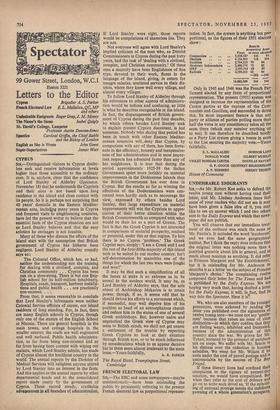FRENCH ELECTORAL LAW
SIR,—The BBC and some newspapers—maybe unintentionally—have been misleading the public by persistently referring to the present French electoral law as proportional represen-
tation. In fact, the system is anything but pro- portional, as the figures of their 1951 election show :
Communists Gaullists Socialists .. Moderate Inderendaots Radicals
• • • • • • • .
• • • •
Votes to 5,038,587 4,134,885
2,764,210
2,496,570 2,353,544 2,194,213 Proportion Scots In Seat; vales obtaind 144 94 118 104
79 94
72 83 68 85 63 84
—282 —346
544 544 18,982,009
.=„.,■••■
Only in 1945 and 1946 was the French Par- liament elected by any form of proportional representation. The present (1951) system was designed to increase the representation of the Centre parties at the expense of the Cony munists and Gaullists, and succeeded in doing this. Its most important feature is that any party or alliance of parties polling more than half the votes in any constituency takes all the seats there (which may number anything uP to ten). It can therefore be described briefly as a Party List system giving a bonus in seats to the List securing the majority vote.—Yours faithfully,
E. L. MALLALIEU DONALD WADE GORDON LANG GILBERT MURRAY VIOLET BONHAM CARTER DOUGLAS SAVORY G. P. GOOCH GEOFFREY SHAKESPEARE A. P. HERBERT JEREMY THORP5
House of Commons


























































 Previous page
Previous page